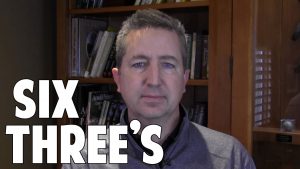
In this mental game video, you’ll learn how to bounce back in golf.
Let’s start with a few questions…
Do you find it a struggle to bounce back after having a bad round?
Does one hole ruin your entire round?
Or have you ever started a round really hot, then the wheels come off and you ruin your score?
In this video, you’ll get a great mental tip to help you overcome these problems.
TSG Sports Psychologist Dr. Thad Leffingwell will show you his “Six Three’s” technique to get hot and stay hot during the round!
What's Covered: How to bounce back in your round and become more cognitive about playing better and fixing the problems.
Golf Pros Featured:
Instructors Featured: Thad Leffingwell
Video Duration: 4:15
Watch This Video Now!
Normally, this video in our step-by-step, course-based training is only available to our All Access Members...
But I'll let you watch this ONE video today only... because I can already tell I'm going to like you !

Video Transcription:
Hi guys. I’m Doctor Thad Leffingwell, sports psychology instructor with Top Speed Golf. I have a couple of questions for you.
Have you ever gotten off to a rough start in a round, and it takes several holes to shake it off and refocus?
Or have you ever gotten off to a hot start, but got out of your comfort zone and ruined a good score with the wheels coming off, costing you a chance at a really low score?
I’m here today with a tpi for your mental game that can help you overcome these two problems.
It might not seem like it, but the root of these two different scenarios is similar from a mental standpoint. A big number early in a round can cause us to feel like a chance at a good score is lost before the round has hardly begun.
An excellent start or front nine, can cause us to start thinking about the low score that is suddenly possible.
In both cases our minds drift away from the task at hand, the next shot or hole, and instead start thinking about the implications of past results that can’t be undone.
To play your best golf, you need to stay as much in the present as possible. I could just give you simple advice like play one shot or one hole at a time.
While that would be ideal, and maybe even rarely achieved, it is unrealistic for most players to be able to do that consistently.
Golf is a game where the score matters, and it is a tempting distraction. I have an idea of how to find a compromise between focus in the present and awareness of score.
To do this, we’re going to leverage a pretty common psychological experience in golf. For many of us, the turn to the back nine in a round gives us renewed focus. It is a clean slate, a fresh start.
Often that psychological experience results in improved play on the holes that follow. You’ve probably had that experience.
We could use that process to address the problem of inconsistent focus. You know the fact that a round of golf is 18 holes is kind of an accident of golf history going back to the 18th century.
The fact that we think of scores in terms of two nines is just more or less a custom drawn from the architecture of modern golf courses. They thought it would be convenient to return to the clubhouse halfway through the round.
From a psychological standpoint I find it more useful to think of a round of golf as comprised not of two nines, but rather as six sets of three holes each, and to calculate a score relative to par of each set before the next set starts.
There are a lot of advantages to this. Three holes is a small set, but still gives you a couple of holes to offset a bogey or a big number. It is also a small enough set that you are unlikely to post such a good score that it alone would take you out of your comfort one.
But I think the biggest advantage of the six threes approach is that it gives you five opportunities to turn the page and refocus like can happen when we turn to the back nine.
By having the same focus in the last set of three as the first, you have a better chance of staying in the moment and focusing on the task at hand, giving you a chance to post your best score.
When you start a round, I recommend that the first thing you do is get out a marker and draw four new lines in the score card to create six sets of three. Draw a line between holes 3 and 4, 6 and 7, 12 and 13, and 15 and 16.
As you play during the round, record your score relative to par in that set just as you would at the end of nine holes, and reset your focus on the next three.
When you make the turn five times instead of just once, I think you’ll find your focus to be more consistent throughout the round, and your scores to improve.
So stop playing two nines and try playing six threes. You’ll maintain a more consistent focus, and as a result, could shoot lower scores. As always, have fun and enjoy the game.
If you like this video and would like to see more instruction on the mental side of the game, please leave a comment or email and let us know.

